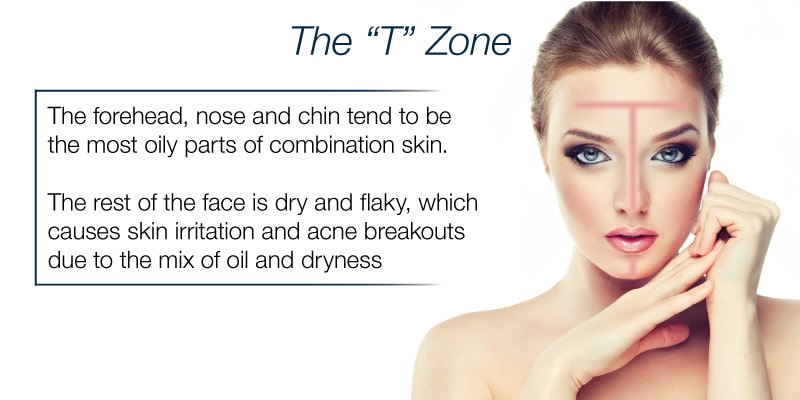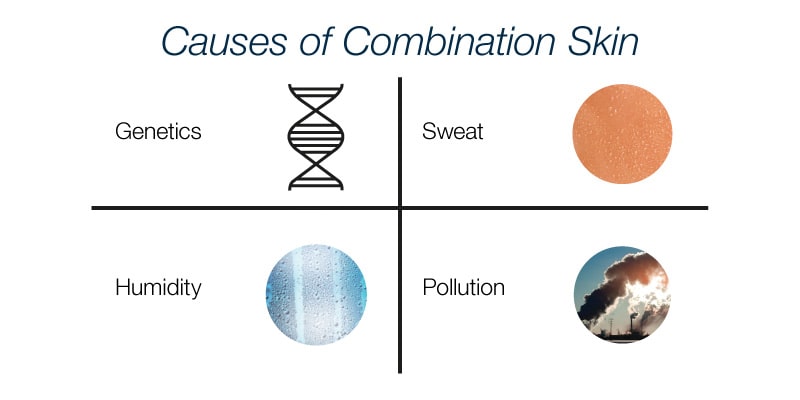Combination skin can be challenging to manage, with some areas of your face dry while others are oily. Our comprehensive guide will help you understand your skin type and provide practical tips for keeping it healthy and balanced. Learn about the best skin care products, lifestyle factors, and common myths about combination skin. Trust our expert advice to help you achieve a glowing, healthy complexion.
Balancing Act: The Ultimate Guide to Managing Combination Skin
I. overview of combination skin and its challenges
Combination skin can be a challenging skin type to manage, as it involves dealing with both dry and oily skin in different areas of the face. Understanding the causes and characteristics of combination skin is key to developing an effective skincare routine.

Overview Of Combination Skin And Its Challenges
It's characterized by both oily and dry areas on the face, with the T-zone (forehead, nose, and chin) typically being oilier and the cheeks and other areas being drier. Dealing with these conflicting skin concerns can be frustrating, but with the right approach, it's possible to achieve a healthy, balanced complexion. In this article, we'll explore the unique challenges of combination skin and provide tips and tricks for managing it effectively. From the best skincare products to the right lifestyle habits, we've got you covered.
Read more: Blemish Skin 101: Understanding, Treating, and Preventing Blemishes
II. Understanding Combination Skin
Combination skin is characterized by having both dry and oily areas on the face. The T-zone, which includes the forehead, nose, and chin, is typically oily, while the cheeks and other areas may be dry or normal. This makes it difficult to find products that work well for all areas of the face.

TZone-min
One of the main causes of combination skin is genetics. However, other factors such as hormonal changes, weather, and environmental factors like pollution and UV radiation can also contribute to the development of combination skin.
There are different types of combination skin, including dry-oily and normal-oily. Dry-oily combination skin involves having dry patches on the cheeks and oily skin on the T-zone, while normal-oily combination skin has normal skin on the cheeks and oily skin on the T-zone.

understanding-combination-skin.
Understanding the unique characteristics of your skin can help you develop a personalized skincare routine that addresses your specific needs.
III. Tips for Managing Combination Skin
When it comes to managing combination skin, it's important to find the right balance between addressing dry areas and oily zones. This can be challenging, but with the right skin care routine and lifestyle habits, you can keep your skin looking healthy and glowing. Here are some tips for managing combination skin:

Tips For Managing Combination Skin
- Choose the right skin care products: Look for products specifically formulated for combination skin, such as gentle cleansers, alcohol-free toners, lightweight moisturizers, and oil-free serums. Avoid heavy creams or oil-based products that can clog pores and exacerbate oily areas.
- Adjust your routine to address different skin zones: Apply different products to dry and oily areas of your face to cater to their unique needs. For example, use a gentle cleanser on your dry cheeks and a more clarifying cleanser on your oily T-zone.
- Don't skip the moisturizer: Even if you have oily areas, it's important to moisturize your skin to prevent dryness and maintain a healthy skin barrier. Look for lightweight, oil-free moisturizers that won't clog pores or exacerbate oily areas.
- Exfoliate regularly: Exfoliating can help to remove dead skin cells and prevent clogged pores. However, be gentle and avoid over-exfoliating, which can cause irritation and dryness.
- Consider your diet and stress levels: A healthy diet and stress management can also play a role in managing combination skin. Eating a balanced diet rich in fruits, vegetables, and healthy fats can help to support healthy skin, while stress reduction techniques such as meditation and exercise can help to keep stress levels in check.
By following these tips, you can keep your combination skin looking its best and maintain a healthy, glowing complexion.
IV. Common Myths About Combination Skin
Combination skin can be a tricky skin type to manage. It's characterized by both dry and oily areas, which can make finding the right skin care routine challenging. Unfortunately, there are many misconceptions about combination skin that can make things even more difficult. In this article, we'll address some of the most common myths about combination skin and provide you with the truth about how to manage it effectively.

Common Myths About Combination Skin
Myth #1: Oily skin requires harsh products
Many people believe that the oily areas of combination skin need harsh, drying products to keep them under control. However, this is a myth. Overly harsh products can strip the skin of its natural oils, causing it to produce even more oil to compensate. This can lead to a vicious cycle of dryness and oiliness.
Truth: Use gentle products that balance your skin
Instead of using harsh products, choose gentle, pH-balanced products that are designed to balance the skin. Look for cleansers and toners that are specifically formulated for combination skin, and avoid products that contain alcohol, which can be drying. Additionally, use a lightweight moisturizer that won't clog pores, but will still provide the hydration your skin needs.
Myth #2: Moisturizing will make oily areas worse
Another common myth about combination skin is that moisturizing will make the oily areas worse. People with combination skin often avoid moisturizing their skin, thinking it will exacerbate the problem.
Truth: Moisturize regularly to keep your skin balanced
In reality, skipping moisturizer can make combination skin worse. Dry areas of the skin can produce more oil to compensate for the lack of moisture, leading to increased oiliness in the T-zone. To keep your skin balanced, choose a lightweight, non-comedogenic moisturizer that won't clog your pores. Apply it after cleansing and toning your skin.
Myth #3: Combination skin is caused by poor hygiene
Some people believe that combination skin is caused by poor hygiene. They think that not washing your face regularly or not using the right products can cause the skin to become oily and dry.
Truth: Combination skin is largely genetic
While it's important to practice good hygiene, combination skin is largely genetic. If your parents have combination skin, it's likely that you'll have it too. Environmental factors like weather, pollution, and stress can also contribute to combination skin.
Conclusion:
Managing combination skin can be a challenge, but it's important to separate fact from fiction when it comes to skin care. Avoiding harsh products, moisturizing regularly, and understanding the genetic causes of combination skin can all help you develop a more effective skin care routine. By following these tips and avoiding common myths, you can achieve healthy, balanced skin.
V. Conclusion
In summary, combination skin can be a challenge to manage due to its unique combination of dry and oily areas. However, with the right skin care routine and lifestyle adjustments, it's possible to keep your skin looking and feeling healthy. Remember to use products specifically formulated for combination skin, adjust your routine based on the needs of different areas of your face, and pay attention to factors like diet and stress management that can affect your skin's overall health.
We hope this article has provided you with helpful tips and debunked common myths about combination skin. If you have any additional tips or experiences to share, we encourage you to leave a comment and join the conversation. For more information on combination skin, please refer to the credible sources listed below.
References:
- American Academy of Dermatology Association. "Combination Skin: What It Is and How to Care for It."
- Healthline. "Combination Skin: What It Is, How to Identify It, and How to Treat It."
https://www.healthline.com/health/beauty-skin-care/combination-skin

